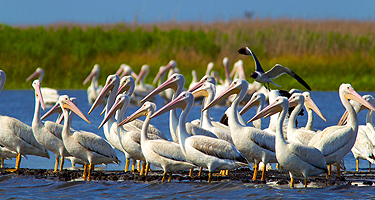http://bpholdingsninje.wordpress.com/2013/04/20/early-restoration-projects-gulf-of-mexico-restoration-bp-getsatisfaction/
In 2012, work began on the initial set of early restoration projects identified through an agreement BP signed with state and federal trustees in April 2011. The trustees also approved two new early restoration projects in December 2012 following a public comment period. These projects are designed to improve nesting habitats for birds and loggerhead sea turtles on a number of Gulf Coast beaches. Under the early restoration framework agreement, BP agreed to fund up to $1 billion in early restoration projects to accelerate efforts to restore natural resources injured as a result of the Deepwater Horizon accident. The framework requires BP and the trustees to agree upon the potential projects, funding and the natural resources' benefits the projects are expected to provide. The trustees then implement the projects. The agreement between BP and the trustees makes it possible for restoration to begin at an earlier stage of the NRD process than usual. NRD restoration projects are typically funded only after the NRD assessment is complete and a final settlement has been reached or a final court judgment has been entered. This process often takes many years, and restoration is often delayed during that time. The early restoration framework agreement allows the parties to expedite projects to restore, replace or acquire the equivalent of injured natural resources in the Gulf soon after an injury is identified, reducing the time needed to achieve restoration of those resources. Projects under way The eight initial early restoration projects that were initiated in 2012 are expected to cost approximately $60 million. Alabama • Alabama Dune Restoration Cooperative Project aims to restore and protect 55 acres of coastal sand dune habitat with native vegetation, protective fencing and informative signs. •Alabama Marsh Island Restoration Project aims to protect 24 acres of existing salt marsh habitat and create 50 acres of additional salt marsh habitat in Portersville Bay. Florida •Florida Boat Ramp Enhancement and Construction Project aims to repair two existing public boat ramps and construct two new public boat ramps as well as visitor kiosks in Escambia County to improve access to the public for water and boating recreational activities. •Florida (Pensacola Beach) Dune Restoration Project aims to plant approximately 475,000 native plants an average of 15 to 60 feet seaward of the existing primary dunes along an eight mile length of Pensacola Beach near the western end of Santa Rosa Island in Escambia County, Florida. Louisiana •Louisiana Lake Hermitage Marsh Projectaims to create 104 acres of marsh within the Barataria Hydrologic Basin in Plaquemines parish. •Louisiana Oyster Cultch Project aims to provide 850 acres of productive oyster cultch habitat on public oyster seed grounds in six locations in coastal Louisiana and construction of an oyster hatchery facility. Mississippi •Mississippi Oyster Cultch Project aims to provide approximately 1,400 acres of productive oyster cultch habitat in Hancock County and Harrison County. • Mississippi Artificial Reefs Project aims to add approximately 100 acres of near-shore artificial reefs to the 201-acre footprint of the existing reefs in the Mississippi Sound. SOURCE: http://www.bp.com/sectiongenericarticle800.do?categoryId=9048905&contentId=7082585 RELATED ARTICLE: http://current.com/groups/bp-holdings-main/94102361_early-restoration-projects-gulf-of-mexico-restoration-bp.htm https://getsatisfaction.com/bpholdingsaldren/topics/c2bu57gf5rsaq http://www.linkedin.com/groups/Early-restoration-projects-Gulf-Mexico-4969130.S.234045985 Early restoration projects, Gulf of Mexico restoration, BP Holdings
0 Comments
Leave a Reply. |
| BP Holdings |
|

 RSS Feed
RSS Feed